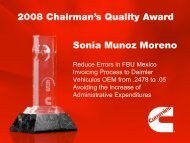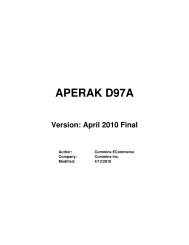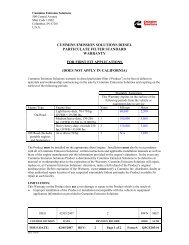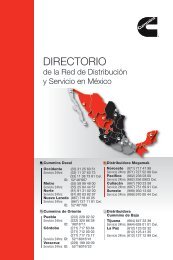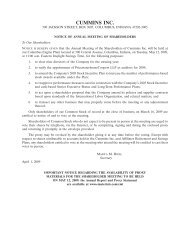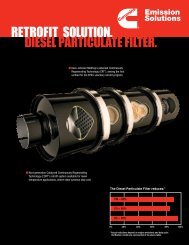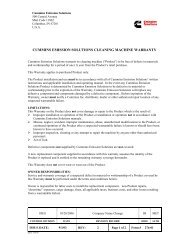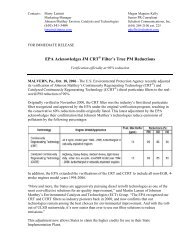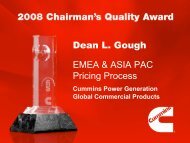Cummins Inc. 2007 Sustainability Report
Cummins Inc. 2007 Sustainability Report
Cummins Inc. 2007 Sustainability Report
Create successful ePaper yourself
Turn your PDF publications into a flip-book with our unique Google optimized e-Paper software.
Other Significant Direct Air Emissions<br />
Category (Metric Tons) 2004 2005 2006<br />
NOx 2,490 2,556 2,855<br />
CO 553 564 629<br />
PM10 167 171 192<br />
VOC<br />
Number of <strong>Report</strong>ing sites<br />
854 791 2,537<br />
NOx, CO and PM10 79 229 229<br />
Number of <strong>Report</strong>ing sites VOCs 38 38 53<br />
Data for NOx, CO, PM and CO 2 for 2005 and 2006 were developed from the 229 sites reporting fuels and electricity<br />
for the GHG inventory. Totals for VOC for these same years are based on data from the manufacturing and larger<br />
non-manufacturing sites, of which, 38 reported in 2005 and 53 in 2006.<br />
Emissions from diesel fuel used in product testing applications and No. 2 fuel oil, propane and natural gas used in boilers<br />
and furnaces were derived using EPA AP-42 Compilation of Air Pollutant Emission Factors, 1996.<br />
AP-42 emissions conversions used for large diesel engines are based on obsolete technology, so emissions data is overstated.<br />
Energy and Emissions<br />
Direct and Indirect Energy Use<br />
The energy data provided represent electricity used<br />
at the Company’s facilities to generate power for<br />
manufacturing operations, power produced and<br />
sold to the regional grid and power used for facility<br />
heating and cooling purposes. These data are<br />
derived from 229 sites in scope of <strong>Cummins</strong> Climate<br />
Leaders GHG inventory, which are the sources of the<br />
greenhouse gas emissions in the <strong>Cummins</strong> inventory<br />
presented in the table on pages 64 and 65.<br />
Historical energy and fuels use data indicate that<br />
<strong>Cummins</strong> achieved an absolute GHG emissions<br />
reduction of 2.3 percent in 2005 versus the year<br />
2000. This equates to a 28 percent overall and a 20<br />
percent, inflation adjusted, GHG intensity reduction<br />
expressed in tons of CO 2e (equivalents) per million<br />
dollars in net sales.<br />
This significant emissions reduction has been<br />
accomplished through increases in efficiency in<br />
part associated with environmental improvement<br />
projects at <strong>Cummins</strong> that employ Six Sigma tools<br />
and methodology. Similarly, fuel-use reductions<br />
tied to engine-testing efficiencies initiatives, which<br />
themselves yield substantial environmental benefits,<br />
represent supplemental benefits from what is<br />
primarily a quality assurance tool.<br />
Fuels, electricity use and other sources and their<br />
resultant emissions, in general, have increased<br />
from 2005 to 2006. Total direct and indirect<br />
US emissions increased by 5.1% over the same<br />
timeframe, whereas total non-US emissions<br />
increased by 5.5%. Total worldwide emissions in<br />
absolute terms increased by 5.2%. The company<br />
experienced sales growth of 14.5% from 2005 to<br />
2006, yielding an 8% GHG intensity reduction. The<br />
GHG intensity reduction based on inflation adjusted<br />
2006 sales in 2005 constant dollars was 4.8%.<br />
Environment<br />
67






